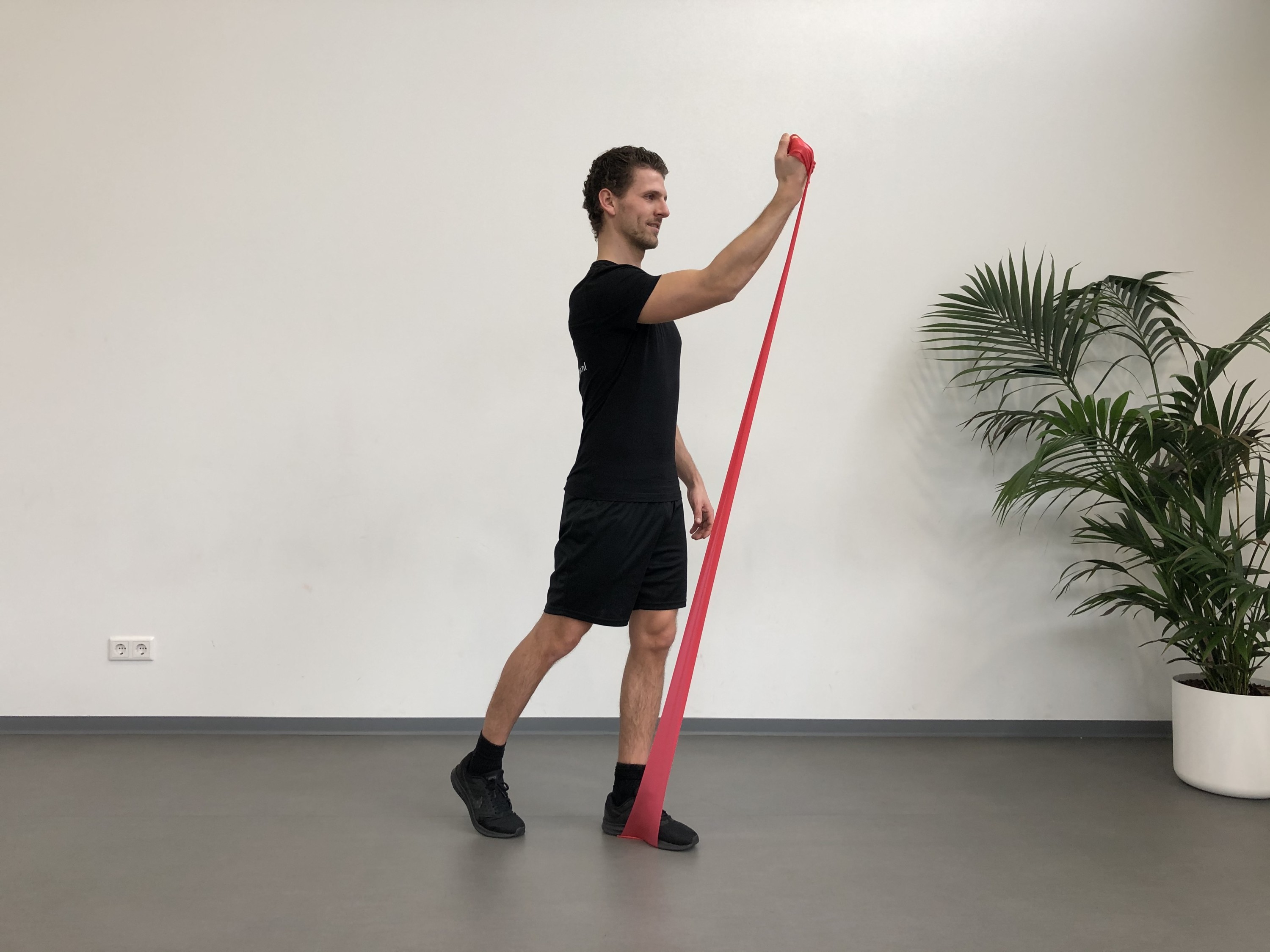
Biceps injuries (Proximal Biceps injurie)
Complaints to the muscle in the upper arm can often be caused by the tendon of the large upper arm muscle (biceps). The main function of this muscle is to bend the elbow. The complaints often manifest themselves when the arm is raised above the head and with heavy lifting. On this page you will find all information about this complaint and matching exercises for recovery.
1. Zittend bicep curl met elastiek
Ga op een stoel zitten en pak een elastiek. Zorg dat je met je voeten op het uiteinde van het elastiek staat om spanning te creëren. Pak Vervolgens het andere uiteinde vast, plaats je elleboog in je zij en breng de hand waarmee je het elastiek vast hebt naar schouder. Breng je hand vervolgens weer terug naar beginpositie en herhaal dit.
2. Biceps curl
Ga op heupbreedte staan, pak met je hand een gewicht vast van je aangedane arm, plaats je elleboog in je zij, breng het gewicht omhoog naar je schouder terwijl je elleboog in je zij blijft en strek je arm weer langzaam terug.
3. Biceps curl schouder press
Ga zitten op de stoel en houd de toe rugleuning vrij. Laat de armen langs het lichaam hangen. Breng het gewicht naar de schouder door de ellebogen te buigen. Draai daarna de handpalmen naar buiten en strek de arm boven de schouders uit. Breng de armen weer op een rustig tempo naar de startpositie.
4. Uppercut
Gebruik hiervoor een resistentband, zorg dat deze goed onder de voet zit. Buig de elleboog en breng rek op de band door met een vloeiende beweging de gebogen arm naar boven te stoten.
Resistance band
Hard. Compact. Qualitatively.

Dumbell
Hard. Compact. Qualitatively.

What means proximal biceps injuries?
The biceps is a large upper arm muscle with elbow flexion as its main function. It is attached to the forearm (radial head) and spans the upper arm and the shoulder joint before connecting to the front of the shoulder blade (supraglenoid tubercle, coracoid process).
The causes of proximal biceps injuries
Irritation, overuse, deterioration in tendon quality (tendinopathy), aging processes (degenerative changes) and acute trauma are the most common causes of biceps injuries.
The symptoms of proximal biceps injuries
Irritation of the long biceps tendon can cause pain at the front of the shoulder when under load, for instance when lifting your arm. A tendon tear can lead to pain, weakness and a change in appearance of the biceps muscle known as the popeye phenomenon. Heavy lifting and using the arm above your head are the main causal factors.
The treatment of proximal biceps injuries
If the biceps tendon is injured or reduced in quality there are two treatment options:
Option 1, heavy strength training with your physiotherapist. This will either improve its strength or (if already partially torn) tear it completely. It may sound strange, but a complete tear does not cause a lot of weakness. It is sometimes the best option to get rid of the pain and maintain 90% of your strength.
Option 2 - Surgery to remove part of the tendon and attach the remaining tendon to the upper arm. Rehabilitation can take between 6 and 12 months.
Did you know?
The biceps has 2 attachment points at the front of the shoulder. If one tendon tears, the remaining tendon will provide functionality. If the biceps tendons tear completely, you’ll lose between 5-15% of strength in the upper arm. Other muscles, like the coracobrachialis muscle, will take over a large part of its function.
Synonyms
Biceps injury, upper arm muscles, popeye
Advice
If you have any questions regarding the exercises, doubt if you are doing them correctly or aren’t sure they are suited for your condition, please contact your physiotherapist for support.
Attention:
Yourbody.coach offers a range of exercises. Yourbody.coach can not be held responsible if you develop injuries. Always consult your physiotherapist or specialist.